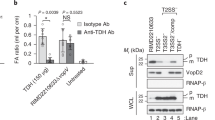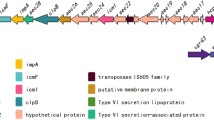Abstract
EspB of enterohemorrhagic Escherichia coli O157:H7 is one of the type III proteins, categorized as translocators, that are secreted in abundance. To define the secretion determinants, different fragments of EspB were fused in recombinant proteins and the proteins secreted into media analyzed by Western blot. The results indicated that the C-terminal 30 residues of EspB were dispensable for secretion whereas the N-terminal first 117 residues played a major role. However, this N-terminal segment alone was not sufficient to confer the secretion. To acquire basic activity, the EspB fusion protein had to contain the N-terminal segment and another segment consisting of either residues 118–190 or residues 191–282. It is possible that the N-terminal region may act as the primary component of the secretion signal while other determinants help to maintain a conformation of EspB favorable for secretion. However, alternative mechanisms cannot be completely excluded. Not withstanding this, the signal for the type III secretion of EspB is apparently distinct from those previously described for the secretion of effector proteins such as Yops in Yersinia.





Similar content being viewed by others
References
Abe A, de Grado M, Pfuetzner RA, Sanchez-Sanmartin C, Devinney R, Puente JL, Strynadka NC, Finlay BB (1999) Enteropathogenic Escherichia coli translocated intimin receptor, Tir, requires a specific chaperone for stable secretion. Mol Microbiol 33:1162–1175
Anderson DM, Schneewind O (1997) A mRNA signal for the type III secretion of Yop proteins by Yersinia enterocolitica. Science 278:1140–1143
Cheng LW, Anderson DM, Schneewind O (1997) Two independent type III secretion mechanisms for YopE in Yersinia enterocolitica. Mol Microbiol 24:757–765
Chuang CH, Hsu SC, Hsu CL, Hsu TC, Syu WJ (2001) Construction of a tagging system for subcellular localization of proteins encoded by open reading frames. J Biomed Sci 8:170–175
Crane JK, McNamara BP, Donnenberg MS (2001) Role of EspF in host cell death induced by enteropathogenic Escherichia coli. Cell Microbiol 3:197–211
Donnenberg MS, Yu J, Kaper JB (1993) A second chromosomal gene necessary for intimate attachment of enteropathogenic Escherichia coli to epithelial cells. J Bacteriol 175:4670–4680
Elliott SJ, Hutcheson SW, Dubois MS, Mellies JL, Wainwright LA, Batchelor M, Frankel G, Knutton S, Kaper JB (1999a) Identification of CesT, a chaperone for the type III secretion of Tir in enteropathogenic Escherichia coli. Mol Microbiol 33:1176–1189
Elliott SJ, Yu J, Kaper JB (1999b) The cloned locus of enterocyte effacement from enterohemorrhagic Escherichia coli O157:H7 is unable to confer the attaching and effacing phenotype upon E. coli K-12. Infect Immun 67:4260–4263
Elliott SJ, Krejany EO, Mellies JL, Robins-Browne RM, Sasakawa C, Kaper JB (2001) EspG, a novel type III system-secreted protein from enteropathogenic Escherichia coli with similarities to VirA of Shigella flexneri. Infect Immun 69:4027–4033
Feldman MF, Muller S, Wuest E, Cornelis GR (2002) SycE allows secretion of YopE-DHFR hybrids by the Yersinia enterocolitica type III Ysc system. Mol Microbiol 46:1183–1179
Foubister V, Rosenshine I, Donnenberg MS, Finlay BB (1994) The eaeB gene of enteropathogenic Escherichia coli is necessary for signal transduction in epithelial cells. Infect Immun 62:3038–3040
Hsu SC, Lin HP, Wu JC, Ko KL, Sheen IJ, Yan BS, Chou CK, Syu WJ (2000a) Characterization of a strain-specific monoclonal antibody to hepatitis delta virus antigen. J Virol Methods 87:53–62
Hsu SC, Syu WJ, Ting LT, Wu JC (2000b) Immunohistochemical differentiation of hepatitis D virus genotypes. Hepatology 32:1111–1116
Hueck CJ (1998) Type III protein secretion systems in bacterial pathogens of animals and plants. Microbiol Mol Biol Rev 62:379–433
Ide T, Laarmann S, Greune L, Schillers H, Oberleithner H, Schmidt MA (2001) Characterization of translocation pores inserted into plasma membranes by type III-secreted Esp proteins of enteropathogenic Escherichia coli. Cell Microbiol 3:669–679
Karlinsey JE, Lonner J, Brown KL, Hughes KT (2000) Translation/secretion coupling by type III secretion systems. Cell 102:487–497
Kenny B, Jepson M (2000) Targeting of an enteropathogenic Escherichia coli (EPEC) effector protein to host mitochondria. Cell Microbiol 2:579–590
Kenny B, Lai LC, Finlay BB, Donnenberg MS (1996) EspA, a protein secreted by enteropathogenic Escherichia coli, is required to induce signals in epithelial cells. Mol Microbiol 20:313–323
Kenny B, Abe A, Stein M, Finlay BB (1997a) Enteropathogenic Escherichia coli protein secretion is induced in response to conditions similar to those in the gastrointestinal tract. Infect Immun 65:2606–2612
Kenny B, DeVinney R, Stein M, Reinscheid DJ, Frey EA, Finlay BB (1997b) Enteropathogenic E. coli (EPEC) transfers its receptor for intimate adherence into mammalian cells. Cell 91:511–520
Knutton S, Rosenshine I, Pallen MJ, Nisan I, Neves BC, Bain C, Wolff C, Dougan G, Frankel G (1998) A novel EspA-associated surface organelle of enteropathogenic Escherichia coli involved in protein translocation into epithelial cells. EMBO J 17:2166–2176
Kodama T, Akeda Y, Kono G, Takahashi A, Imura K, Iida T, Honda T (2002) The EspB protein of enterohaemorrhagic Escherichia coli interacts directly with α-catenin. Cell Microbiol 4:213–222
Lai LC, Wainwright LA, Stone KD, Donnenberg MS (1997) A third secreted protein that is encoded by the enteropathogenic Escherichia coli pathogenicity island is required for transduction of signals and for attaching and effacing activities in host cells. Infect. Immun 65:2211–2217
Link AJ, Phillips D, Church GM (1997) Methods for generating precise deletions and insertions in the genome of wild-type Escherichia coli: application to open reading frame characterization. J Bacteriol 179:6228–6237
Lloyd SA, Norman M, Rosqvist R, Wolf-Watz H (2001) Yersinia YopE is targeted for type III secretion by N-terminal, not mRNA, signals. Mol Microbiol 39:520–531
McDaniel TK, Kaper JB (1997) A cloned pathogenicity island from enteropathogenic Escherichia coli confers the attaching and effacing phenotype on E. coli K-12. Mol Microbiol 23:399–407
McNamara BP, Donnenberg MS (1998) A novel proline-rich protein, EspF, is secreted from enteropathogenic Escherichia coli via the type III export pathway. FEMS Microbiol Lett 71–78
Nataro JP, Kaper JB (1998) Diarrheagenic Escherichia coli. Clin Microbiol Rev 11:142–201
Pallen MJ, Dougan G, Frankel G (1997) Coiled-coil domains in proteins secreted by type III secretion systems. Mol Microbiol 25:423–425
Parsot C, Hamiaux C, Page AL (2003) The various and varying roles of specific chaperones in type III secretion systems. Curr Opin Microbiol 6:7–14
Perna NT, Mayhew GF, Posfai G, Elliott S, Donnenberg MS, Kaper JB, Blattner FR (1998) Molecular evolution of a pathogenicity island from enterohemorrhagic Escherichia coli O157:H7. Infect Immun 66:3810–3817
Roe AJ, Hoey DE, Gally DL (2003) Regulation, secretion and activity of type III-secreted proteins of enterohaemorrhagic Escherichia coli O157. Biochem Soc Trans 31:98–103
Sambrook J, Russell DW (2001) Molecular cloning: a laboratory manual, 3rd edn. Cold Spring Harbor Laboratory, Cold Spring Harbor, New York
Taylor KA, O'Connell CB, Luther PW, Donnenberg MS (1998) The EspB protein of enteropathogenic Escherichia coli is targeted to the cytoplasm of infected HeLa cells. Infect Immun 66:5501–5507
Tu X, Nisan I, Yona C, Hanski E, Rosenshine I (2003) EspH, a new cytoskeleton- modulating effector of enterohaemorrhagic and enteropathogenic Escherichia coli. Mol Microbiol 47:595–606
Vandeyar MA, Weiner MP, Hutton CJ, Batt CA (1988) A simple and rapid method for the selection of oligodeoxynucleotide-directed mutants. Gene 65:129–133
Wachter C, Beinke C, Mattes M, Schmidt MA (1999) Insertion of EspD into epithelial target cell membranes by infecting enteropathogenic Escherichia coli. Mol Microbiol 31:1695–1707
Wainwright LA, Kaper JB (1998) EspB and EspD require a specific chaperone for proper secretion from enteropathogenic Escherichia coli. Mol Microbiol 27:1247–1260
Weiner MP, Felts KA, Simcox TG, Braman JC (1993) A method for the site-directed mono- and multi-mutagenesis of double-stranded DNA. Gene 126:35–41
Wolff C, Nisan I, Hanski E, Frankel G, Rosenshine I (1998) Protein translocation into host epithelial cells by infecting enteropathogenic Escherichia coli. Mol Microbiol 28:143–155
Acknowledgements
This research was supported in parts by grant 89-B-FA22-2-4 (Program for Promoting Academic Excellence of Universities) from the Department of Education and grants NSC 89-2320-B010-105 and NSC 90-2320-B-010-053 from the National Science Council, Taiwan, ROC.
Author information
Authors and Affiliations
Corresponding author
Rights and permissions
About this article
Cite this article
Chiu, HJ., Lin, WS. & Syu, WJ. Type III secretion of EspB in enterohemorrhagic Escherichia coli O157:H7. Arch Microbiol 180, 218–226 (2003). https://doi.org/10.1007/s00203-003-0579-7
Received:
Revised:
Accepted:
Published:
Issue Date:
DOI: https://doi.org/10.1007/s00203-003-0579-7




